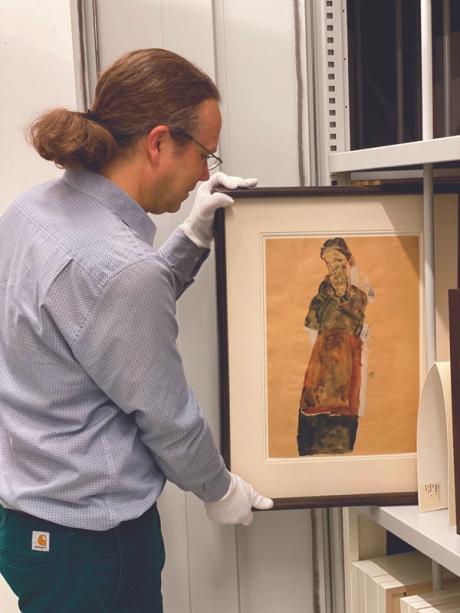
When the Folkwang Museum in Essen bought a watercolor by Egon Schiele earlier this year, it was also recovering part of its history.
The works of 1911, Standing woman covering face with both hands, had already been purchased once for the Folkwang, more than a century ago, by the founder of the museum. Karl Ernst Osthaus corresponded regularly with Schiele and had purchased 14 watercolors and one painting at the time of the artist’s death in 1918. This amounted to the largest museum collection of Schiele’s works of its time.
But in 1937, standing woman was confiscated during the Nazis’ crusade against “degenerate” modern art. More than 20,000 works were seized from over 100 museums in an operation orchestrated by Joseph Goebbels. The museums were declared “purified” in 1938 and much of the art was sold overseas to fund weapons programs.
A part is still circulating. But German museums have no legal rights to the art seized during the purge. The law of May 31, 1938, by which Goebbels legitimized the spoliation of museums, has never been repealed and the confiscations are still valid.
Thus, for museums, recovering missing works means remaining attentive to opportunities in the art market. “Every once in a while something pops up,” says Tobias Burg, the curator of Folkwang’s collection of drawings, prints and watercolors. “You have to be quick. Fewer and fewer of these works are available on the market. Most are in museums.
The Folkwang confiscated more works of art than any other German museum – around 1,400 works were seized in total. The confiscations jeopardized the museum’s future after World War II and “still hurts” today, Burg says.
standing woman is the 25th confiscated work that Folkwang has bought back. He first borrowed the private owner’s watercolor for an exhibition examining the museum’s tumultuous history, which ended in January. The purchase, announced in March, was funded by a bequest from Essen couple Walter and Liselotte Griese, who stipulated that the fund was to be used to purchase Expressionist art.
A handful of purchases
A handful of purchases by art museums seized from their 1937 collections are announced each year. Last year, the Kunstpalast in Düsseldorf bought 1925 from Lovis Corinth Still life with lilacs and anemones, one of the artist’s last works, first purchased by the museum director shortly after being painted. And in 2021, the Kunsthalle Mannheim bought a work by Otto Mueller, kneeling female nude.
The purchase was facilitated by the Ernst von Siemens Kunststiftung, which, like the Culture Foundation of the German Federal States, often helps with such acquisitions. “Most museums don’t have an acquisition budget,” explains Martin Hoernes, general secretary of the Ernst von Siemens Kunststiftung. “We are generous in these cases. We often finance a third of the price, but we like that the State also contributes. »
Sometimes museums seek to fill holes in their pre-war art collections with works similar to those confiscated but not identical, Hoernes says. “We also help fill those gaps,” he says. “German museums have lost their modernity because of seizures. To redeem confiscated art is to recover a piece of their identity.
East German museums had few opportunities to buy art on international markets before 1989 – so they had to play catch-up to fill the voids left by “degenerate” art confiscations. In 2016 the Dresden State Art Collections purchased a painting by Ernst Ludwig Kirchner, Street scene ahead hair salonconfiscated from the City Art Gallery.
The Kunstmuseum Moritzburg in Halle recovered a watercolor by Kandinsky from 1925 and bought two paintings by Max Liebermann in 2020. These survived the ‘degenerate’ art seizures but were sold by the museum during the Nazi era because, as the city official in charge of culture put it: ‘They are no longer usable for exhibitions because Liebermann is Jewish”.
Not all recovery attempts are successful. Thomas Köllhofer, the curator of prints, drawings and watercolors at the Mannheim Kunsthalle, still regrets a failed drawing by Oskar Kokoschka of a nude donated to Christie’s in 2013. After careful preparation to raise funds, the Kunsthalle had to give up when bidding has increased dramatically. above the high estimate. “It hurts when they go to anonymous buyers and we don’t know where they are anymore,” says Köllhofer.
Still, he is optimistic that more confiscated works will resurface for sale, although these are mostly on paper. The paintings seized from Mannheim are now mostly in museums or high-level private collections, he says.
“In many cases, we know where they are, but we cannot retrieve them,” says Köllhofer. “It’s painful to see these works in New York or Basel, but it also makes me proud of our predecessors when I see the quality of what they bought and the important collections where they are now.”
